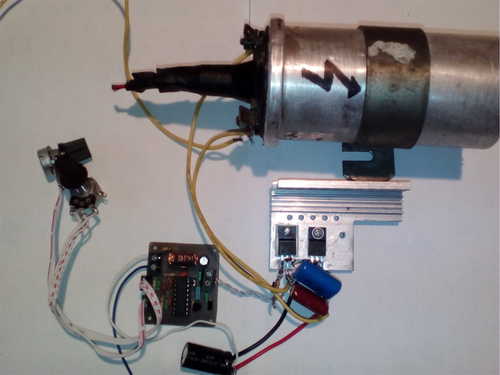This circuit works with dangerous voltages. I don't take any responsibility for any direct or indirect consequences (legal issues, property damage, injuries, deaths...) of building and using this device. You do so at your own risk.
I wanted an ignition coil driver with variable power (duty cycle) and frequency, so I decided to design and build this. The TL494 (=KA7500, DBL494, etc...) integrated circuit is somewhat old and may be a bit "outdated", but it is very widely available, cheap and has all the required functions. Power MOSFETs are also widely available.

Schematic diagram (driver electronics) (click for full resolution)
This circuit is quite simple. It runs off a 12 volt (11..15 tested) power supply. Other voltages should be usable too, depending on the used parts (refer to the datasheets). There is no feedback, the duty cycle and frequency can be adjusted by the user (these are set with two potentiometers - a 50 kΩ potentiometer connected to P2 for frequency adjustment and a 10 kΩ potentiometer connected to P3 for duty adjustment). The internal oscillator of the TL494 is used to generate this signal. The frequency is variable between approx. 200 and 700 Hz, depending on the potentiometer's position and R1, R4, C4. The first error op-amp of U1 is not used for any purpose, the second error amplifier is used to enable/disable the device, it's connected to the connector P5 (pin 1 is connected to Vcc, pin 3 is connected to GND and pin 2 is the signal, pulled up to Vcc. Connecting it to GND will enable the device, leaving it pulled up or over 5V will leave the output off. I connected it to GND with a jumper, keeping it reserved for future use for undervoltage lockout and thermal protection. This circuit is designed to drive a power MOSFET (e.g. IRFP460). The gate drive portion consists of R2 (output current limit), the integrated output transistors in U1 (TL494) and D1 (charge) and R3 and Q1 (discharge). This signal is connected to P4, which is the output of this board, connected to the gate of the power MOSFET (in the power electronics part). The power MOSFET drives the ignition coil.
The power MOSFET has its source connected to ground, its drain to one of the input pins of the ignition coil (the second pin is connected to the power rail). The power supply MUST BE PROPERLY FILTERED (e.g. with a ≥4700 µF low ESR electrolytic capacitor + a 1 µF foil capacitor in parallel). To limit spikes from getting back into the power supply, put an inductor (test or calculate the value) in series with this device.
The MOSFET should have an 18V Zener diode connected between its gate (Zener cathode) and source. It's a good idea to connect a capacitor in parallel with the coil's primary to prevent the voltage from shooting up too high (I use around 1uF - this limits the peaks to around 300 V - results may vary depending on capacitance and coil) - this can also return some unused energy from the primary back to the filtering cap through resonant action (voltage reverses and the MOSFET's built-in diode conducts). The capacitor has to be of high quality! When this is done, it's also a good idea to slow down the turn-on, to do that, connect a Schottky diode in front of the gate (anode to gate) and a resistor (I use around 1kΩ, depends on the MOSFET type, etc.) parallel to the Schottky diode. Right now I use two paralelled GF10NC60KD IGBTs mounted on a heatsink from an old PC PSU and around 1µF across the primary. Proper heatsinking is required!

Finished device, test setup (click for full resolution)
The power can be increased by decreasing the operating frequency - the on-time ("charging time" of the coil and thus the magnetic field intensity) will be higher. I managed to get decent results with C4=330 nF, an IRFP460 MOSFET and primary capacitance increased to 2 µF (but the peak voltage across the MOSFET already exceeded 400 V, even higher capacitance would be better - depends on the exact ignition coil).